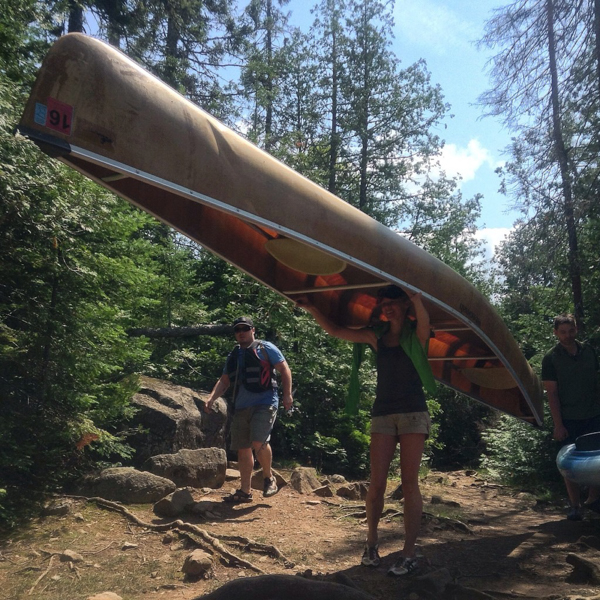Now that you had your chance to drill me with questions in the last post, let me ask you if you feel like you’re in shape. If have any shadow of doubt that you’re not, I’d advise you to not whimsically go on a solo. You wouldn’t do it for a half or full marathon, why would you when your life literally could be on the line?
Let’s consider your major method of transportation up there. Unless you take a hiking trip, your transportation will be via canoe. A calm 10 mph day on land translates to 15 mph (at minimum) on the lake. Wind creates waves. Waves are a canoe’s worst enemy. Lakes with a “walleye chop” could make it feel you’re as hopeless as a rubber ducky in a wave pool; all it takes is three of them strung together to flip your canoe – knock on wood, I’ve never flipped but I have seen it happen and it’ll destroy your plans. Keep in mind: a day of travel entails about 6–12 hours of paddling and portaging. If it’s blustery, buckle up for a slow, exhausting, and hectic day. Have a few tumultuous days stretched out and your upper body will be as a greaseless Tin Man. Case in point: if you can barely manage a 30 minute workout, you’re probably not ready for 6-12 hours of paddling a canoe and portaging it along with your gear on your back.
Remember, this is a solo trip – you can’t rely on anyone’s help other than yourself. While you have the time now, it’s best to begin working out. You’ll move faster with less effort. It’s actually a huge confidence boost when you pass parties that are dogging it – seriously, my favorite thing is passing people.
Anyway, if you just forego conditioning, I you’ll get tired and sore. When you’re in either or both states combined I can almost guarantee you that you’ll eventually getting frustrated. If you get frustrated, you don’t think clearly. When you don’t think clearly, you grow irrational. And when you grow irrational things can go awry in the blink of an eye. It’s a nasty snowball effect you need to avoid at all costs.
Enough of the costs, it’s time to talk about the benefits. When you work out you push yourself. You’ll understand your limitations. Even better is you’ll surprise yourself with what you can do if you put your mind to it – confidence!

If it’s been awhile for you, I’d recommend easing into a regimen. Don’t be a hero and try to crush a big workout. You’ll be sore for days and it’ll be counterintuitive for helping to keep your body in shape.
Instead set a goal and make weekly progressions to attain it; small victories over time make big results. If you’re soloing via canoe, you’ll be sitting and rowing 80–90% of the time on travel days (approximately 5-10 hours). The other 10–20% will be portaging all your gear on your shoulders from lake to lake (approximately 1-2 hours). Therefore the biggest areas of focus are:
– Core
– Upper Body
– Cardio
Each week I try to get 2–3 workouts that last about an hour long targeting the following muscle groups:
Chest and Back: Various angles and arm/hand placements of 300–400 pushups, 40–50 pull-ups, 6 sets of back flies with dumbbells
Core: Various 15 sets of 25 rep abdominal sit ups and crunches
Arms and Shoulders: 12 stacked sets of various shoulder, bicep, and tricep (e.g. 12 shoulder shrugs, 16 bicep curls, 12 tricep kickbacks would equal 1 stacked set)
Core: 15 reps of 25 various abdominal sit ups and crunches
Bonus: Yoga sessions are surprisingly helpful and are an excellent option for a full body workout. They help promote strength, balance, flexibility, mental focus, and breathing technique. If you can get in a couple of those, it’ll be icing on the cake for your conditioning.
In between those lifting days, I try to build my endurance by running 3-6 miles in the grass/rough terrain off of the paved walking/biking paths. Running off trail helps strengthen my feet and ankles to be able to tolerate the unpaved, uneven, and slippery portages. The grass and weeds provide some resistance too which will help strengthen you even more. It’s even better to run while the terrain is wet and muddy to mimic what it’ll be like when portaging gear in between lakes (inevitably the feet WILL be wet and muddy during these).
If you’re unable to run, try to do some sort of cardio that lasts 30-60 minutes and do a few minutes of ankle workouts. Drench some old sneakers in water and go for a walk in your neighborhood for your cool down so your feet will be conditioned to walking in slippery footwear. It sounds stupid, but, trust me. It’ll help. No one likes having wet feet but I guarantee you that you will have them on your solo. When you have wet feet you can get frustrated. When you get frustrated you…(yeah, you know)…That snowball effect occurs. Condition your mind to be okay with having wet feet.

If you haven’t caught on yet, we’re tackling the mental aspect on multiple fronts. Ease your way into a workout regimen. You’ll slowly build endurance, strength, and confidence within yourself that you can succeed in strenuous activity. While you’re active in a fitness regimen that works for you, let’s take the next step to chart your way to success with:

2 thoughts on “Pre-Solo Physicality: Get in Shape”